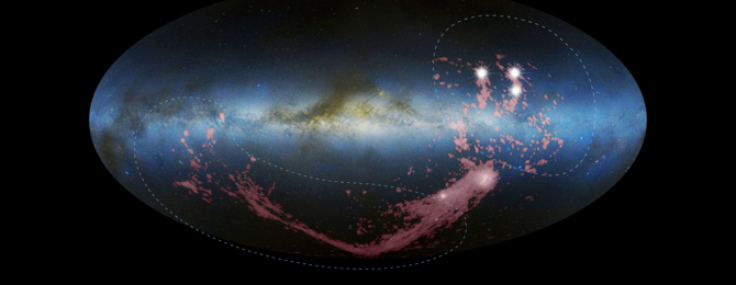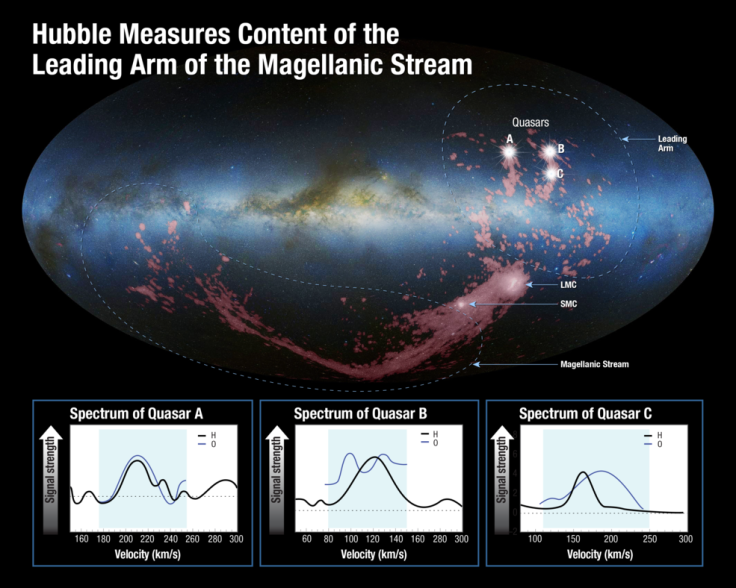When Two Dwarf Galaxies Battle, Who Wins? Hubble Finds Out

Two dwarf galaxies are locked in a cosmic battle just outside our own Milky Way. The only way of figuring out who’s winning the galactic tug-of-war is by turning to NASA’s Hubble Space Telescope, which has been observing the event. According to NASA, Hubble has helped figure out the victor of this cosmic battle using interstellar forensics.
The two galaxies duking it out are the Large Magellanic Cloud and the Small Magellanic Cloud. Both these galaxies orbit each other, as well as orbit the Milky Way. As the two dwarf galaxies orbit each other, they continue tugging at each other, which has led to one of them pulling out a giant cloud of gas from its cosmic adversary.
This massive cloud of gas, which is believed to be around one or two billion years old, is called the Leading Arm. It has been named thus because of its ability to lead the movements of the Magellanic Clouds. This arching collection of gas is about half the size of the Milky Way and connects the two galaxies to our own.
At present, the massive cloud of gas is being gobbled up by the Milky Way, in turn feeding new star birth in our galaxy. However, till now, scientists had no clear idea of which galaxy was doing the pulling and which one’s gas is being fed upon.
“There’s been a question: Did the gas come from the Large Magellanic Cloud or the Small Magellanic Cloud? At first glance, it looks like it tracks back to the Large Magellanic Cloud,” lead researcher Andrew Fox of the Space Telescope Science Institute in Baltimore, said in a statement. “But we’ve approached that question differently, by asking: What is the Leading Arm made of? Does it have the composition of the Large Magellanic Cloud or the composition of the Small Magellanic Cloud?”
Fox and his colleagues made use of a new kind of forensics, using Hubble’s ultraviolet vision to chemically analyze the Leading Arm. They studied the light coming from seven quasars — the bright cores that reside within active galaxies and are located billions of light years away from the Leading Arm. Scientists measured how this light filtered through the giant cloud of gas, using Hubble’s Cosmic Origins Spectrograph.
According to researchers, a real-time example of gas accretion, which is essentially what the Leading Arm is, can be very difficult to observe in galaxies outside the Milky Way because they are too faint and often too far away.

“As these two galaxies are in our backyard, we essentially have a front-row seat to view the action,” said collaborator Kat Barger at Texas Christian University. “With the combination of Hubble and Green Bank Telescope observations, we can measure the composition and velocity of the gas to determine which dwarf galaxy is the culprit.”
The researchers were eventually able to find the chemical “fingerprints” that matched the origins of the Leading Arm.
“We’ve found that the gas matches the Small Magellanic Cloud,” said Fox. “That indicates the Large Magellanic Cloud is winning the tug-of-war, because it has pulled so much gas out of its smaller neighbor.”
According to NASA, gas from the Leading Arm is currently making its way through the disk of the Milky Way and through its journey, is becoming more shredded and fragmented after having interacted with our galaxy’s gas. The new research is considered to be an important example of gases managing to get into galaxies and giving rise to star birth. The researchers involved in this study hope to completely map out the Leading Arm’s size, which still remains unknown to us.
© Copyright IBTimes 2024. All rights reserved.











